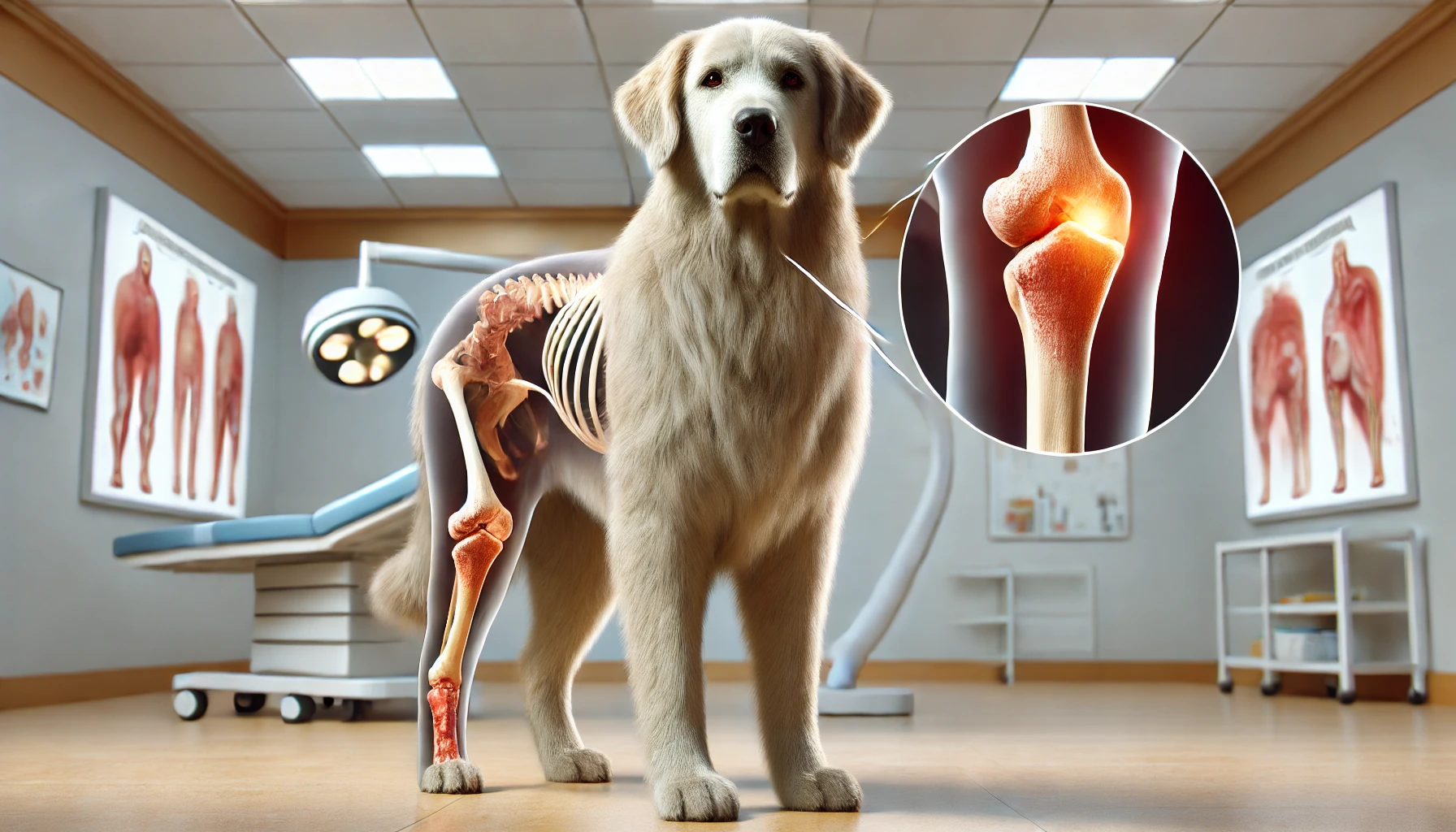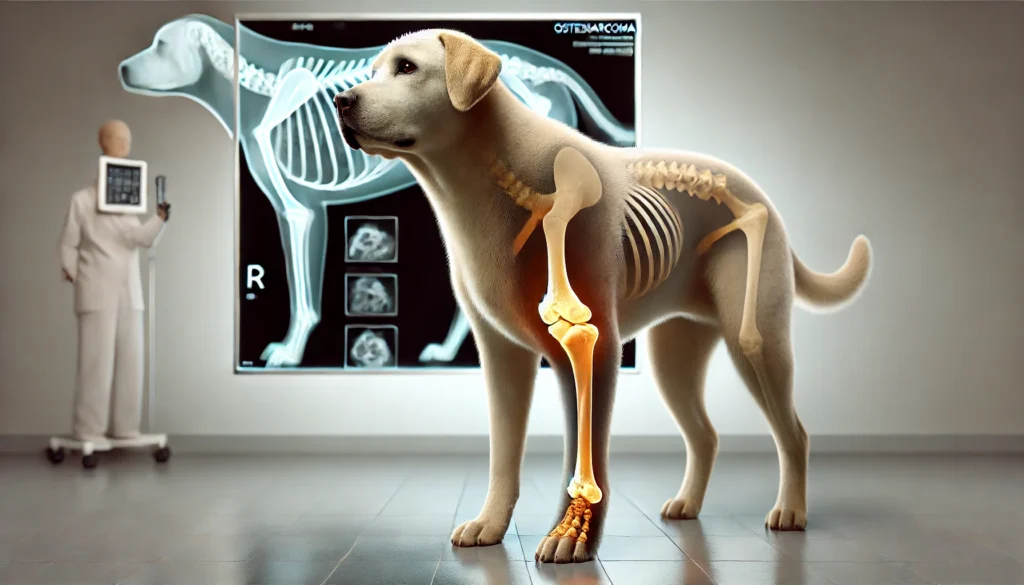osteosarcoma in dogs

Osteosarcoma in dogs is the most common and one of the most aggressive forms of bone cancer found in veterinary practice. This malignant bone tumor primarily affects large and giant breed dogs and often presents with rapid progression, severe pain, and the potential for metastasis (spread) to other parts of the body. Understanding osteosarcoma in dogs is crucial for early detection and treatment, as timely intervention can improve both survival rates and the quality of life for affected dogs.
In this detailed guide, we will explore osteosarcoma in dogs, including its symptoms, causes, diagnostic methods, treatment options, prognosis, and the best ways to support dogs diagnosed with this disease.
What is Osteosarcoma in Dogs?
Osteosarcoma in dogs is a malignant tumor that arises from the bone cells known as osteoblasts, responsible for bone formation. This cancer can occur in any bone but is most commonly found in the long bones of the limbs, such as the femur, tibia, and humerus. Osteosarcoma in dogs is particularly challenging because of its aggressive nature, rapid growth, and tendency to metastasize, especially to the lungs.

The disease causes significant pain, loss of function, and even fractures in the affected bone as the tumor weakens it. If left untreated, osteosarcoma can lead to severe discomfort and a dramatic reduction in the dog’s mobility.
Prevalence and Breeds Affected by Osteosarcoma in Dogs
Osteosarcoma is the most common type of bone cancer in dogs, accounting for up to 85% of all bone tumors in dogs. The disease predominantly affects large breed dogs, particularly those over 7 years of age. Some of the breeds most commonly diagnosed with osteosarcoma in dogs include:
- Rottweilers
- Golden Retrievers
- Labrador Retrievers
- Saint Bernards
- Great Danes
Though osteosarcoma in dogs is rare in small breeds, larger dogs tend to develop it more frequently due to factors like rapid growth and higher bone mass. It’s important for owners of large breeds to be especially vigilant for symptoms of this condition.
Causes and Risk Factors of Osteosarcoma in Dogs
The exact cause of osteosarcoma in dogs remains unknown. However, several factors are believed to contribute to the development of this aggressive cancer.
1. Genetic Factors and Breed Predisposition
There is a strong genetic component in the development of osteosarcoma in dogs. Certain breeds, including the Golden Retriever and Rottweiler, have an increased risk of developing the disease. Genetic mutations in bone-forming cells may predispose these breeds to developing tumors in the bones. Although the exact genes responsible for this predisposition are still under study, genetic research continues to help veterinarians better understand why some dogs are more prone to osteosarcoma than others.
2. Trauma or Injury to the Bone
Trauma or injury to the bones, such as fractures or sprains, may not directly cause osteosarcoma but can potentially increase the risk of abnormal bone growth, which may develop into cancer. While trauma-related bone cancer is more commonly discussed in relation to other species (e.g., osteosarcoma in cats following bone injury), it can still be a risk factor in dogs, especially those with large and rapidly growing bones.
3. Age and Size of the Dog
Osteosarcoma in dogs tends to affect older, large-breed dogs, typically over the age of 7. The rapid bone growth and weight-bearing forces that these breeds experience early in life may increase the likelihood of developing bone tumors later. As dogs age, their bones become more susceptible to the development of malignancies like osteosarcoma.
4. Abnormal Bone Remodeling
Abnormal bone remodeling, a process in which bone is broken down and replaced by new bone tissue, is believed to contribute to the formation of osteosarcoma. Large dogs, in particular, may experience abnormal bone turnover, creating conditions conducive to the development of bone tumors. Osteosarcoma often appears in areas of high bone turnover, such as the humerus or femur.
Signs and Symptoms of Osteosarcoma in Dogs
The symptoms of osteosarcoma in dogs typically begin with subtle signs of discomfort and gradually worsen as the disease progresses. Early detection is vital to improving the prognosis for dogs diagnosed with osteosarcoma.
1. Lameness and Pain
Lameness is often the first sign of osteosarcoma in dogs. As the tumor grows and the bone becomes weakened, dogs may start limping or avoid putting weight on the affected limb. The pain can be severe and often increases after physical activity, leading to reluctance to walk or run. Osteosarcoma humerus pain, or pain in other affected bones, is particularly common and often leads to a noticeable limp.
2. Swelling and Visible Mass
As the tumor grows, it can cause swelling around the affected bone. This swelling may be palpable, and in some cases, a visible mass may form. The mass is usually firm and painful when touched. If the tumor has affected a bone in the limb, owners may notice a visible change in the dog’s gait or posture due to the discomfort caused by the swelling.
3. Decreased Appetite and Weight Loss
Dogs with osteosarcoma often experience a loss of appetite and subsequent weight loss. This is due to the pain, reduced mobility, and metabolic changes caused by the cancer. As the disease progresses, the dog may become weaker, further contributing to weight loss and reduced overall health.
4. Difficulty Breathing and Coughing (Metastasis)
One of the most concerning symptoms of osteosarcoma in dogs is when the cancer metastasizes to the lungs, a common site for spread. In this case, the dog may exhibit signs of respiratory distress, including coughing, labored breathing, and a decreased ability to exercise. Osteosarcoma prognosis worsens significantly when the cancer spreads to distant organs, particularly the lungs.
5. Behavioral Changes
As osteosarcoma in dogs causes increasing pain and discomfort, affected dogs may become more irritable or withdrawn. Dogs may avoid normal activities such as playing or interacting with family members due to the discomfort. Behavioral changes, such as depression or aggression, can be a result of both physical pain and psychological distress.
Diagnosing Osteosarcoma in Dogs
Diagnosing osteosarcoma in dogs involves a combination of clinical examination, imaging, and biopsy. Early diagnosis allows for more effective treatment, so it is important to consult with a veterinarian if any symptoms of osteosarcoma in dogs are observed.
1. Physical Examination and Medical History
A thorough physical examination is the first step in diagnosing osteosarcoma. The veterinarian will assess the dog’s gait, palpate the affected limb, and check for swelling or abnormal masses. The dog’s medical history, including any previous injuries or signs of lameness, will also be reviewed.
2. X-rays and Imaging
X-rays are the primary imaging tool used to identify osteosarcoma in dogs. Radiographs reveal the extent of bone destruction and the presence of a tumor. In some cases, advanced imaging techniques like CT scans or MRIs may be used to get a more detailed view of the tumor and surrounding tissues.
3. Biopsy
A biopsy is essential to confirm the diagnosis of osteosarcoma. A small sample of the tumor is taken and examined under a microscope to determine the presence of cancer cells. The biopsy can distinguish osteosarcoma from other bone conditions or tumors.
4. Bone Scintigraphy
Bone scintigraphy, also known as a bone scan, can be used to detect the spread of osteosarcoma to other bones. A small amount of radioactive material is injected into the dog’s bloodstream, where it binds to active bone cells and helps identify areas where the cancer may have spread.
5. Blood Tests
Blood tests are not typically used to diagnose osteosarcoma, but they can provide valuable information about the dog’s overall health. Elevated levels of alkaline phosphatase (ALP) may indicate bone disease, while blood counts can reveal any signs of infection or anemia.
Treatment Options for Osteosarcoma in Dogs
The treatment for osteosarcoma in dogs depends on the location and extent of the disease. The primary goals are to control pain, extend survival, and improve the dog’s quality of life. Common treatments include surgery, chemotherapy, and radiation therapy.
1. Amputation
Amputation of the affected limb is often the first line of treatment for osteosarcoma in dogs, particularly when the tumor is confined to a single limb. Despite initial concerns, most dogs adjust well to life with three legs, and amputation can provide significant relief from pain. Studies have shown that amputation significantly improves survival rates and the overall prognosis for affected dogs.
2. Chemotherapy
Chemotherapy is typically used in combination with surgery to address any potential metastasis. Drugs like carboplatin and cisplatin are commonly used to treat osteosarcoma in dogs and can help prevent the spread of cancer to other organs, especially the lungs. Chemotherapy can extend survival and improve quality of life, though it does not cure the disease.
3. Radiation Therapy
Radiation therapy can be an effective option for tumors located in areas that are difficult to surgically remove, such as near the spine or pelvis. Radiation can shrink the tumor and alleviate pain, but it is typically used in conjunction with other treatments for the best outcome.
4. Palliative Care
For dogs with advanced osteosarcoma or those who are not candidates for surgery or chemotherapy, palliative care focuses on pain management and maintaining comfort. Medications like NSAIDs and opioids can help control pain, while supportive care like nutritional support ensures that the dog maintains strength during treatment.
Prognosis of Osteosarcoma in Dogs
The prognosis for dogs with osteosarcoma depends on several factors, including whether the cancer has spread, the location of the tumor, and the treatments used. Osteosarcoma prognosis is generally poor without treatment, with dogs living only a few months if left untreated.
However, with aggressive treatment, including amputation and chemotherapy, many dogs can live for 12 to 18 months post-diagnosis. In some cases, dogs may survive even longer, particularly if the cancer has not spread to other organs, such as the lungs.
Advanced Treatment Options for Osteosarcoma in Dogs
While osteosarcoma in dogs is a challenging diagnosis, treatment advances have provided new options that can significantly improve survival rates and quality of life. The treatment plan for osteosarcoma in dogs typically involves a combination of surgery, chemotherapy, radiation therapy, and palliative care, depending on the stage of the disease, the location of the tumor, and the dog’s overall health.
1. Limb-Sparing Surgery for Osteosarcoma in Dogs
In certain cases, limb-sparing surgery may be considered as an alternative to amputation, especially if the tumor is located in an area where preserving the limb is possible. Limb-sparing surgery involves removing the tumor while attempting to preserve as much of the bone as possible. In many instances, this is followed by reconstruction of the bone with a prosthetic or bone graft.
While not as common as amputation, limb-sparing surgery may be an option for dogs with osteosarcoma in locations such as the humerus or femur, where the tumor is not too extensive. The procedure can help preserve the dog’s mobility and appearance, which may be particularly important for dog owners who want to avoid amputation.
However, limb-sparing surgery requires precise planning and often involves longer recovery periods and more intensive follow-up care than amputation. It’s important to discuss the risks and benefits of this option with a veterinary oncologist to determine if it’s the best approach for your dog.
2. Chemotherapy for Osteosarcoma in Dogs
Chemotherapy remains a cornerstone in the treatment of osteosarcoma in dogs, particularly for preventing metastasis to the lungs and other parts of the body. After the primary tumor is surgically removed (whether by amputation or limb-sparing surgery), chemotherapy is used to address any microscopic cancer cells that may have spread but are not yet detectable.
Chemotherapy Drugs Used for Osteosarcoma in Dogs
- Carboplatin: This is the most commonly used chemotherapy drug for osteosarcoma in dogs. It works by interfering with the DNA in cancer cells, preventing them from dividing and growing. Studies have shown that carboplatin can extend survival by several months and improve quality of life.
- Cisplatin: Another chemotherapy drug used to treat osteosarcoma, though it is less commonly used due to its side effects, particularly kidney toxicity. It may be prescribed if carboplatin is not effective or suitable.
- Doxorubicin: This chemotherapy drug is sometimes used in combination with other agents for treating osteosarcoma, especially when other forms of treatment fail.
While chemotherapy for osteosarcoma in dogs can be effective in reducing the risk of metastasis, it does not cure the disease. Side effects, such as nausea, loss of appetite, and a decrease in immune function, are common but can be managed by adjusting the treatment plan.
3. Radiation Therapy for Osteosarcoma in Dogs
Radiation therapy can be an essential part of managing osteosarcoma in dogs, particularly for dogs who are not candidates for surgery or for tumors that are inoperable. Radiation works by using high-energy radiation beams to target and shrink tumors, reducing pain and inflammation and potentially slowing the cancer’s progression.
Radiation therapy may be recommended for:
- Pain management: In cases where the tumor is causing significant pain, such as in the pelvic bone or shoulder, radiation can provide relief by shrinking the tumor and reducing pressure on the surrounding tissues.
- Inoperable tumors: For tumors that cannot be surgically removed (e.g., tumors located near vital organs), radiation therapy may help control the disease and prolong life.
- Adjunct therapy: Radiation is often used after surgery, especially if there is a risk that cancerous cells have been left behind.
Though radiation therapy can significantly reduce pain and improve mobility, it requires multiple sessions and is usually accompanied by side effects such as temporary skin irritation or hair loss. It is typically used in conjunction with surgery and chemotherapy to maximize treatment success.
4. Palliative Care for Osteosarcoma in Dogs
Palliative care is an important aspect of managing osteosarcoma in dogs, especially in cases where surgery, chemotherapy, or radiation are no longer viable options, or if the cancer has advanced too far. The goal of palliative care is to provide the dog with comfort, manage pain, and maintain the highest possible quality of life.
Pain Management
Pain is a significant issue for dogs with osteosarcoma, particularly as the tumor weakens the bone and causes discomfort. Pain management is achieved through a combination of the following:
- Non-steroidal anti-inflammatory drugs (NSAIDs): These medications, such as carprofen or meloxicam, are commonly prescribed to reduce inflammation and pain.
- Opioids: In cases of severe pain, stronger medications like morphine or fentanyl patches may be used.
- Steroids: Low doses of corticosteroids can help reduce inflammation and swelling, providing additional pain relief.
Supportive Therapies
- Nutritional support: Dogs with osteosarcoma may experience a reduced appetite due to pain or the side effects of treatment. Special diets, appetite stimulants, or feeding tubes may be necessary to ensure the dog gets adequate nutrition.
- Physical therapy: Dogs that have undergone amputation or have mobility issues due to their tumor can benefit from physical therapy. Techniques such as hydrotherapy, massage, and controlled exercises can help maintain muscle strength and mobility.
- Mental and emotional support: Providing a calm and supportive environment is essential for dogs with osteosarcoma. Since this disease can cause behavioral changes due to pain and discomfort, it’s important to keep the dog’s stress levels low. Spending time with your dog, providing mental stimulation, and offering comfort can improve their overall well-being.
Tips
From hot spots to severe bacterial invasions, skin infections in dogs can spread like wildfire—do you know the warning signs before it’s too late?
5. Alternative and Complementary Treatments
Some owners may explore alternative or complementary therapies for managing osteosarcoma in dogs. While these therapies are not a replacement for traditional treatment methods, they may offer supportive benefits:
- Acupuncture: This ancient practice can help reduce pain and inflammation, providing additional comfort for dogs with osteosarcoma.
- Herbal remedies: Certain herbal supplements, such as turmeric or CBD oil, may help reduce inflammation and provide pain relief. However, it’s essential to consult with a veterinarian before introducing any herbal or natural treatments.
6. Follow-Up Care and Monitoring
Even after treatment, dogs diagnosed with osteosarcoma require ongoing monitoring. Regular follow-up visits to the veterinarian are crucial to assess the dog’s response to treatment, manage side effects, and catch any signs of metastasis early. Common follow-up care protocols include:
- Regular X-rays or CT scans to monitor for lung metastasis or bone spread.
- Blood tests to monitor overall health and the dog’s immune system, especially after chemotherapy.
- Pain management adjustments as the dog’s condition changes over time.
Long-Term Management and Survival Rates of Osteosarcoma in Dogs
The survival rate for dogs with osteosarcoma depends heavily on the treatment approach, the stage of the disease at diagnosis, and whether metastasis is present.
Amputation and Chemotherapy: Long-Term Survival
For dogs that undergo amputation followed by chemotherapy, the life expectancy for osteosarcoma in dogs can be extended significantly. With surgery and chemotherapy, many dogs can live anywhere from 12 to 18 months, and some dogs live even longer. In rare cases, if the tumor has not metastasized and the dog responds well to treatment, survival can extend up to two years or more.
Prognosis for Dogs with Metastasis
If osteosarcoma has spread to the lungs or other parts of the body by the time of diagnosis, the prognosis is much poorer. Osteosarcoma prognosis in dogs with metastasis is typically 4 to 6 months without treatment. However, with aggressive treatment that includes chemotherapy, survival time can be extended, but the chances of a full recovery are very slim.
End-of-Life Care
For dogs who are in the terminal stages of osteosarcoma or have experienced significant metastasis, end-of-life care focuses on ensuring comfort and managing pain. The decision to transition to end-of-life care is a deeply personal one for pet owners, and a veterinarian can assist in making the process as peaceful as possible for both the dog and the family.
Conclusion: Caring for a Dog with Osteosarcoma
Osteosarcoma in dogs is a serious and aggressive cancer, but with early diagnosis and the right treatment approach, many dogs can live for months or even years with a good quality of life. Amputation, chemotherapy, radiation therapy, and palliative care offer valuable treatment options, while ongoing monitoring and supportive therapies can help manage symptoms and improve comfort.
As a pet owner, staying informed and proactive in the management of osteosarcoma in dogs is essential. If your dog has been diagnosed with osteosarcoma, work closely with your veterinarian or veterinary oncologist to create a tailored treatment plan that prioritizes your dog’s well-being.
Remember, while the road ahead may be difficult, your dog’s resilience and your commitment to their care can make a significant difference in their comfort and longevity.
1. How long do dogs live with osteosarcoma?
The lifespan of a dog with osteosarcoma depends on several factors, including the stage at diagnosis, whether the cancer has metastasized, and the treatment options chosen. Without treatment, the survival time is typically 3 to 6 months. However, with aggressive treatment, including amputation and chemotherapy, many dogs can live for 12 to 18 months, and some may survive up to 2 years or longer. The prognosis is better if the cancer has not spread to other organs, such as the lungs.
2. What are the first signs of osteosarcoma in dogs?
The first signs of osteosarcoma in dogs often include:
Lameness or a noticeable limp, especially after activity.
Pain or reluctance to move or put weight on the affected limb.
Swelling or a visible mass around the bone, especially in the limbs.
Behavioral changes, such as increased irritability or withdrawal due to pain.
Decreased appetite or weight loss as the disease progresses.
Since these symptoms often resemble those of a simple injury, early diagnosis can sometimes be missed, making regular vet check-ups essential, especially in older, large-breed dogs.
3. What are 5 symptoms of osteosarcoma?
The key symptoms of osteosarcoma in dogs include:
Lameness or limping – Often the first sign, especially after physical activity.
Pain – The affected limb becomes painful due to bone weakening from the tumor.
Swelling or a visible mass – A hard, sometimes tender swelling at the site of the tumor, often seen in the limbs.
Loss of appetite and weight loss – Due to pain and the systemic effects of cancer.
Respiratory issues (if metastasis occurs) – Dogs may develop coughing, labored breathing, or exercise intolerance if the cancer has spread to the lungs.
4. What dog breeds are prone to osteosarcoma?
Large and giant breeds are most commonly affected by osteosarcoma, especially dogs over the age of 7. Some of the breeds most prone to developing this type of bone cancer include:
Rottweilers
Golden Retrievers
Labrador Retrievers
Saint Bernards
Great Danes
Irish Wolfhounds
Doberman Pinschers
These breeds tend to have higher bone mass and rapid growth during their early years, factors that increase the risk of developing osteosarcoma.
5. Can dogs beat osteosarcoma?
While osteosarcoma is an aggressive and often fatal cancer, it is possible for dogs to “beat” it in the sense of living with the disease for extended periods with the right treatment. Amputation of the affected limb, combined with chemotherapy, is the most effective treatment and can improve both survival time and quality of life. Many dogs survive for 12 to 18 months post-diagnosis, and some can live longer if the cancer has not metastasized. However, osteosarcoma is rarely cured, and the chances of a complete recovery are slim.
6. Can osteosarcoma be cured?
Unfortunately, osteosarcoma in dogs is not curable. The cancer is aggressive, and it usually spreads to the lungs or other parts of the body, even with treatment. However, with surgical removal (often amputation of the affected limb) and chemotherapy, the disease can be managed, and the dog can live longer with a good quality of life. Palliative care is also an option for dogs where curative treatments are not possible, focusing on pain relief and comfort. Early diagnosis and timely treatment can help extend survival, but osteosarcoma remains a challenging disease to completely overcome.






